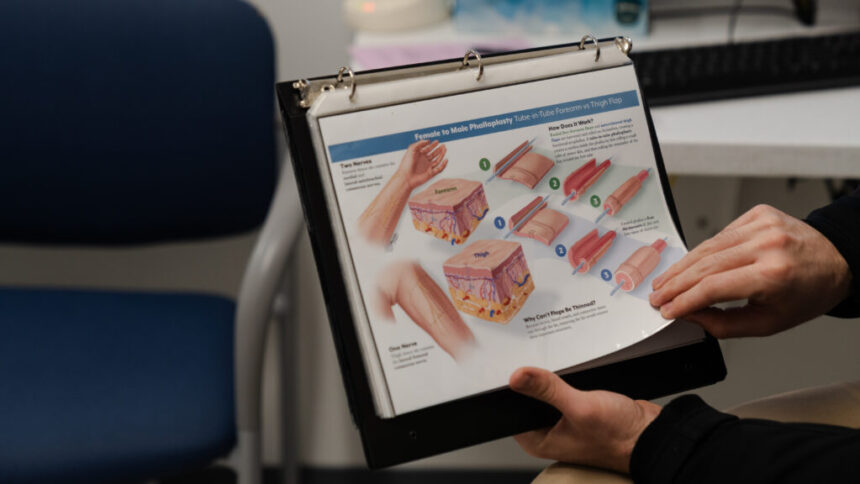Gender-affirming surgery has become a life-changing experience for many transgender individuals in the United States. For patients like Wendy Grogan, undergoing procedures such as vocal and facial surgeries, top surgery, and vaginoplasty can feel like a rebirth. Grogan described her decision to undergo these surgeries as a transformation where the old version of herself would die on the operating table, and a new version would emerge.
The demand for gender-affirming surgery has increased significantly in recent years, with advancements in health coverage playing a crucial role in improving access to these procedures. Medicare lifted a ban on coverage in 2014, leading to a rise in the number of surgeries performed annually. From 2016 to 2019, the number of gender-affirming surgeries nearly tripled in the U.S., with genital surgeries also seeing a significant increase. This surge in demand has led to more physicians seeking training, resulting in advances in surgical techniques and greater accessibility for patients.
However, the progress in providing gender-affirming care is facing challenges due to political controversies surrounding trans health care. In recent years, 26 states have passed legislation limiting access to gender-affirming care for youth, with some lawmakers attempting to restrict adult access as well. Several states have already banned state Medicaid coverage for gender-affirming surgeries, raising concerns among trans patients and advocates about potential rollbacks in access to life-changing procedures.
One of the most complex and politically contentious aspects of gender-affirming surgery is bottom surgery, which includes procedures like phalloplasty and vaginoplasty. These surgeries are tailored to individual preferences and needs, with options ranging from urethral lengthening in phalloplasty to regular dilation after vaginoplasty. Patients have various choices, such as vulvoplasty or orchiectomy, depending on their desired outcomes.
For individuals like Harrison, a trans man working as a firefighter paramedic, the decision to undergo phalloplasty was motivated by practical considerations, such as the ability to pee standing up in communal settings. This commitment to undergoing gender-affirming surgery underscores the significance of these procedures in improving the quality of life for transgender individuals.
Despite the administrative hurdles and long waiting periods associated with gender-affirming surgery, patients like Grogan emphasize the importance of finding trusted surgeons and taking the time to make informed decisions about their surgical journey. As the field of gender-affirming surgery continues to evolve, it is crucial to uphold access to these life-changing procedures for transgender individuals seeking to align their physical bodies with their gender identity.
But with each successive surgery, Grogan felt closer to her true self. “I wake up and I’m happier,” she said. “I see things in the mirror that I want to see. And it’s just absolutely amazing.”
Survey data from the 2015 U.S. Transgender Survey, which includes nearly 20,000 people, showed that receiving gender-affirming surgery was associated with a 42% reduction in psychological distress and 44% reduction in suicidal ideation when compared to those who wanted it but hadn’t gotten it.
It may seem paradoxical that a medical intervention can be seen as lifesaving, while also involving so much active choice. The potential regret somebody might feel after surgery is a point of major contention in the cultural arguments over young people’s access to gender-affirming care. When it comes to surgical treatment (which minors receive extremely rarely), one meta-analysis from 2021 shows that less than 1% of participants who had any gender-affirming procedure regretted it. The exact percentage of people who “detransition” is likely low as well, but research is limited and the experience is more complicated than politics portrays.
Despite the increase in surgeries over the years, it’s a “perpetuated misconception” that brand new swaths of people who want surgery are appearing out of nowhere, or have somehow been lured into making these decisions, said Devin O’Brien-Coon, a plastic surgeon and clinical director of the Brigham & Women’s Center for Transgender Health in Boston. He and others note that it’s actually impossible to say if demand itself for gender-affirming surgeries has truly increased, because the U.S. has never had the capacity to meet existing requests.
Now, surgeons all over the country see anxiety in patients over the future of these procedures, but their own opinions vary on just how much the political climate may affect surgical practices. “It should be no surprise that trans people that are listening to [attacks on transgender rights] are like ‘Jesus, insurance covers my surgery today, but are they going to cover it next month, or in the new year?’” said Maurice Garcia, the director of the Cedars-Sinai Transgender Surgery and Health Program in Los Angeles. Still, some clinicians doubt that the surgery could completely disappear the same way it did decades ago. Despite political pushback, there’s more acceptance of trans people both in American culture at large and in medical settings now than there was then. “You can’t really put the genie back in the bottle of pretending they don’t exist,” said O’Brien-Coon.
The rise of gender-affirming surgery in the U.S.
While gender-affirming surgeries are on the rise in the U.S., the procedures themselves aren’t new. Many historians date the first genital surgeries to the 1920s in Berlin. And it’s said that Roman emperor Elagabalus begged doctors for female genitalia.
In the U.S., the first gender-affirming surgery clinic opened in 1966 at Johns Hopkins, hoping to provide trans people with the relief that psychoanalysis couldn’t provide. The surgeries had already been performed for 15 years in Europe, and about 2,000 times total worldwide. But the Baltimore clinic closed just 13 years later, after being met with intense bias and stigma from hospital leaders. (The then-head of plastic surgery once described transgender patients as “hysterical,” “freakish,” and “artificial.”)
For the rest of the century, trans patients who wanted to receive genital surgery often had to go abroad to Thailand, Serbia, or other places where industries blossomed with no American competition. Stigma kept clinicians away. “Nobody really wanted to treat [trans patients] because they felt like treating them would be a commitment to take care of them long term, and they didn’t want to be associated with that patient population,” said Garcia. While top surgery could be performed relatively easily — it’s similar to breast augmentations or reductions done on cisgender people — only a few Americans continued to offer bottom surgeries.
One of those experts was Stanley Biber, a pioneer of vaginoplasties in the U.S. and perhaps the country’s busiest gender-affirming surgeon. Biber began performing surgeries during the years that the clinic at Hopkins was still open. And for decades after it closed, he continued in the small town of Trinidad, Colo. Patients came from all across the country for surgery. “It was a Greyhound bus and a cloud of dust,” said Marci Bowers, past president of the World Professional Association for Transgender Health, who began her training in vaginoplasties with Biber in 2003, shortly before his retirement. Bowers, a gynecological surgeon by training who identifies as a woman with transgender experience, is known as one of the first non-cisgender people to perform gender-affirming surgeries.
“In the case of an emerging field like this, where there weren’t a lot of road maps on how to do things and there was so much room for improvement, you have somehow to have a lot of creativity,” she recalled.
Trinidad was a small “Santa Fe Trail” type of town, Bowers said, where she and Biber were the only surgeons of any kind for miles. The people stepping off the Greyhound bus were almost always alone, Bowers remembers. They were usually older, retired, single or divorced, and had lived much of their lives in the closet. After finally coming out as trans, they were often estranged from their families. Insurance wouldn’t cover the procedure, so they always paid in cash. Afterward, they left town without knowing whether any other doctor might understand the procedure enough to be able to address potential future complications. They prepared for the long recovery alone.
After Biber retired, Bowers fully took over the practice.
The patient nodded, scribbling a note in his notebook. He had waited months for this consultation, and would likely wait a year or more for the actual surgery. But he remained hopeful, eager to take the next steps in his gender-affirming journey.
Parisi and O’Brien-Coon carefully explained the procedure, detailing each step and potential outcome. The patient asked about recovery time, potential complications, and post-operative care. He was engaged and curious, absorbing every piece of information like a sponge.
As the consultation continued, O’Brien-Coon performed an Allen test on the patient to determine blood flow to his hand. This test is crucial in a phalloplasty, as the patient’s radial artery will be removed from his arm and transferred to his new penis. The meticulous planning and attention to detail demonstrated by O’Brien-Coon and Parisi reassured the patient that he was in capable hands.
The patient left the office feeling empowered and supported, knowing that he was one step closer to achieving his desired outcome. The road ahead would be long and challenging, but with a dedicated team of healthcare professionals by his side, he felt confident in his decision to undergo gender-affirming surgery.
Gender-affirming surgeries have come a long way since their inception, with more surgeons and training programs focusing on providing safe and effective care for transgender and gender-expansive individuals. While challenges still exist, the field continues to evolve and improve, offering hope and healing to those in need.
As the patient looked out the window on his way home, he saw a rainbow stretching across the sky. It served as a reminder that even in the darkest of times, there is always light and beauty to be found. And with each step he took towards his surgery, he felt like he was moving closer to his own personal rainbow, a symbol of hope and transformation. In the world of gender-affirming surgeries, advancements are constantly being made to improve patient outcomes and satisfaction. One such advancement is the decision to perform the glansplasty, a crucial aspect of phalloplasty surgery, during the second stage of the procedure rather than simultaneously with the skin transfer from the arm to the groin. This change allows for better healing and the growth of micro blood vessels, resulting in a more successful outcome with less need for revisions.
Dr. O’Brien-Coon, a pioneer in gender-affirming surgeries, notes that this shift in practice was not formally taught but rather spread through collaboration and communication among surgeons. This exchange of knowledge has accelerated the progress of surgical techniques and outcomes in the field.
At institutions like NYU, surgeons are pushing the boundaries of what is possible with robotic-assisted techniques for vaginoplasties and efforts to maximize nipple sensation in top surgeries. The goal is always to enhance safety and patient satisfaction simultaneously, ultimately allowing individuals to feel more comfortable in their bodies and experience less dysphoria.
For many patients, gender-affirming surgery represents a turning point in their lives, offering them a sense of peace and acceptance in their bodies. The dedication of surgeons to continually improve their techniques stems from a desire to provide the best possible care for their patients and help them achieve their desired outcomes.
In a follow-up appointment at Dr. O’Brien-Coon’s clinic, a patient who recently completed the final stage of his phalloplasty expressed his gratitude for the transformative experience. As he prepared for a vacation with his wife, he looked forward to enjoying activities like swimming without feeling self-conscious or dysphoric. With advancements in surgical techniques and a commitment to patient-centered care, individuals undergoing gender-affirming surgeries have more opportunities than ever to feel at home in their bodies and live authentically. The world of technology is constantly evolving, with new innovations and advancements being made every day. From cutting-edge smartphones to state-of-the-art artificial intelligence, there is no shortage of new and exciting technologies to explore. One of the most intriguing developments in recent years is the rise of virtual reality (VR) technology.
Virtual reality is a computer-generated simulation of an environment that can be interacted with in a seemingly real or physical way. This technology has been around for decades but has only recently become more accessible to the general public. With the development of affordable VR headsets such as the Oculus Rift and HTC Vive, more and more people are able to experience the wonders of VR technology for themselves.
One of the most exciting applications of VR technology is in the field of gaming. Gamers can now immerse themselves in a virtual world, where they can interact with their surroundings and engage in thrilling adventures like never before. From realistic racing simulations to heart-pounding first-person shooters, the possibilities are endless when it comes to VR gaming.
But VR technology is not limited to just gaming. It also has the potential to revolutionize other industries such as healthcare, education, and entertainment. In the field of healthcare, VR can be used for medical training, allowing students to practice surgeries in a realistic virtual environment. In education, VR can enhance learning by providing students with immersive experiences that bring their lessons to life. And in entertainment, VR can transport viewers to far-off places and allow them to experience events in a whole new way.
However, as with any new technology, there are also challenges that come with the widespread adoption of VR. One of the main concerns is the potential impact on mental health, as prolonged use of VR headsets can lead to issues such as motion sickness and eye strain. There are also ethical considerations to take into account, such as the potential for addiction and the blurring of the lines between reality and virtual reality.
Despite these challenges, the future of VR technology looks bright. As the technology continues to improve and become more affordable, we can expect to see even more exciting applications of VR in the years to come. Whether it’s for gaming, healthcare, education, or entertainment, virtual reality has the potential to change the way we experience the world around us. So strap on your headset and get ready to explore new worlds in ways you never thought possible.







